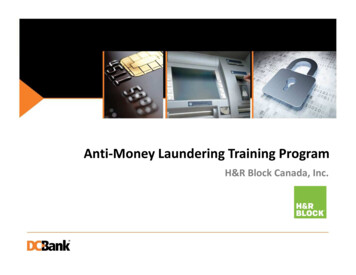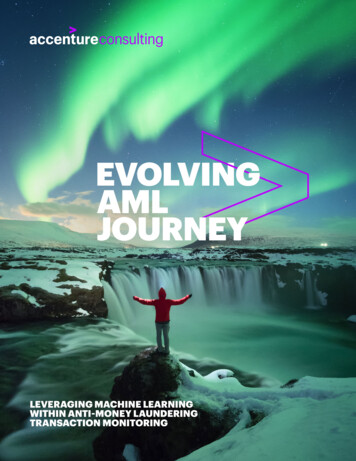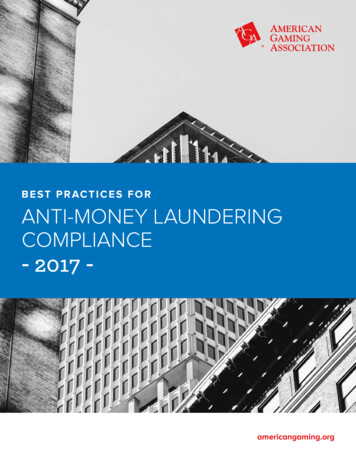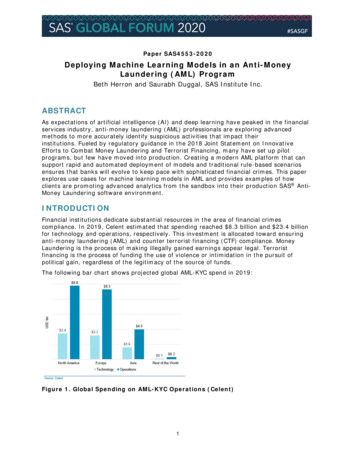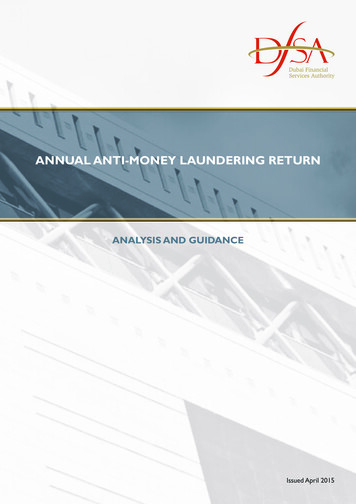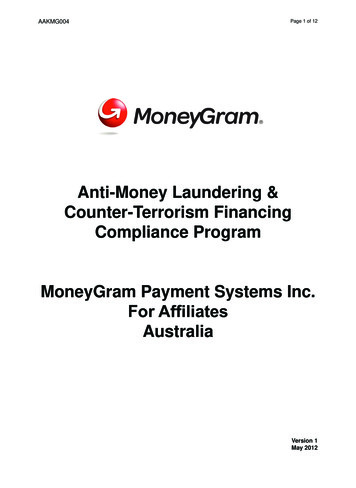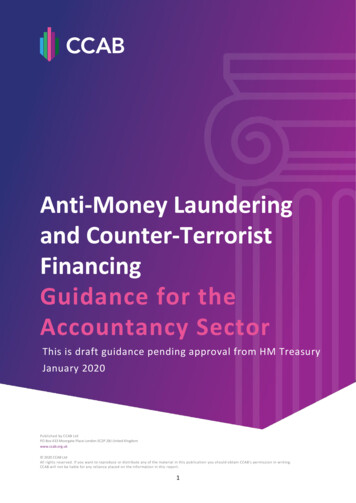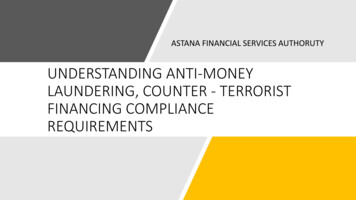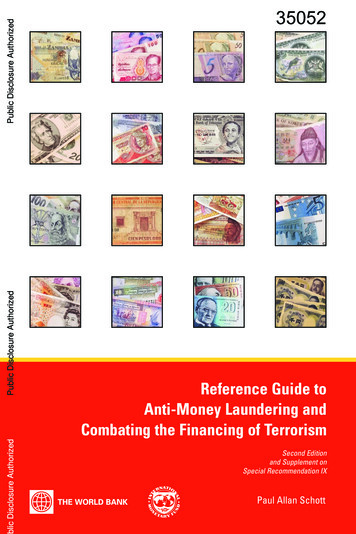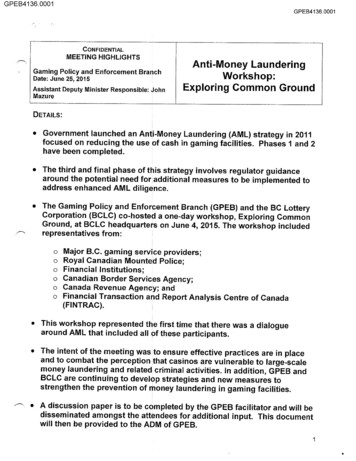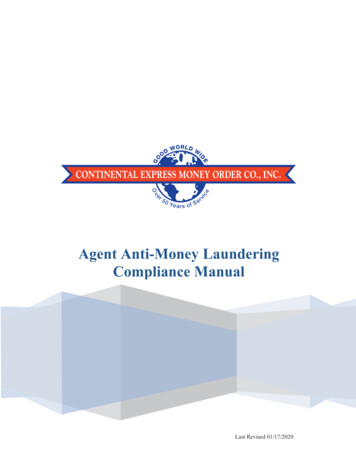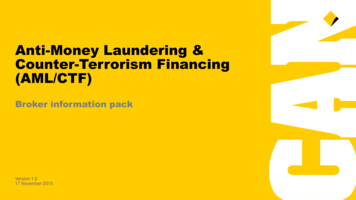
Transcription
Anti-Money Laundering &Counter-Terrorism Financing(AML/CTF)Broker information packVersion 1.017 November 2015
Purpose of the changeThe recent update to the Anti-Money Laundering and Counter-Terrorism Financing Rules (AML/CTF Rules) imposed a numberof additional obligations on the financial sector aimed at preventing money laundering and the financing of terrorism.5%The primary purpose of the regulatory changes is to prevent money laundering and the financing of terrorism, by betterunderstanding the ownership structure of our non-individual customers, and to bring Australia in line with internationalstandards.Consequences of money laundering and terrorismfinancingThe GroupandLicenseesSerious and organised crime isconservatively estimated to cost theAustralian economy 17 billion each yearOurCommunityOurcustomers2* Reputational damage and lack of consumer confidence* Fines and penalties from the regulator* Drop in share price* The consequences of illegal activities* Global and local terrorist attacks* Serious and organised crime* Victims of crime and violence* Financial instability* Threats to mental and physical well-being, including personal safetyChanges to Anti-Money Laundering & Counter-Terrorism Financing (AML/CTF) Broker Information pack – V1.0 17 November 2015
Beneficial OwnersThe definition of Beneficial Owner has been expanded toinclude the concept of “control”. This means that anyindividual who owns or controls 25% or more of thecustomer, either directly or indirectly, is considered aBeneficial Owner.Product Providers also have an obligation to regularlyreview and update KYC information, including BeneficialOwners.Verifying Beneficial OwnershipProprietary companies5%In the case of a proprietary company, Beneficial Owners must be identifiedand verified.Unregulated TrustsUnregulated TrustsAll trustees are considered Beneficial Owners by virtue of control and must beidentified and verified.3Changes to Anti-Money Laundering & Counter-Terrorism Financing (AML/CTF) Broker Information pack – V1.0 17 November 2015
Beneficial Ownership – Example 1Beneficial Owner by virtue of ownership5%Company with various individuals as shareholdersA.70%C.Beneficial ownerB.25%Beneficial owner45%The Beneficial Owners who own orcontrol 25% or more of thecustomer must be identified andverified according to our revisedAML/CTF policies and procedures.Changes to Anti-Money Laundering & Counter-Terrorism Financing (AML/CTF) Broker Information pack – V1.0 17 November 2015
Beneficial Ownership – Example 2Beneficial Owner by virtue of controlA.Company with individual shareholders all less than 25%5%B.E.20%No one qualifies as abeneficial owner by“ownership”, therefore, abeneficial owner by “control”must be identified.20%D.C.20%Beneficial Owner(For this company the Managing20% 20%5Changes to Anti-Money Laundering & Counter-Terrorism Financing (AML/CTF) Broker Information pack – V1.0 17 November 2015Director controls the company)
Beneficial Ownership – Example 3Beneficial Owner by virtue of ownershipCompany with individuals and a company as shareholders - all equal sharesABC Pty LtdThe four individual beneficialowners must be identified andverified according to our revisedAML/CTF policies andprocedures.A.Owner6D.25%B.25%BeneficialXYZ Pty Ltd25%BeneficialOwnerC.25%BeneficialOwnerChanges to Anti-Money Laundering & Counter-Terrorism Financing (AML/CTF) Broker Information pack – V1.0 17 November 2015E. 100%Shareholderof XYZ PtyLtd25%BeneficialOwner
Beneficial Ownership – Example 4Beneficial Owner by virtue of controlF.TrustSettlorA.B.TrusteeTrusteeIf the settlementamount isequal to orgreater than 10,000.7All trustees must be identifiedand verified.The settlor name needs to becollected and verified against thetrust deed where the amountsettled is equal to or greater than 10,000.C.D.E.Trustee Beneficiary BeneficiaryChanges to Anti-Money Laundering & Counter-Terrorism Financing (AML/CTF) Broker Information pack – V1.0 17 November 2015
Settlor of TrustThe Settlor of a Trust is the natural person or legal entity who sets up the Trust and signs the Trust Deed to ‘create’ the trust.In Australia, the Settlor is usually someone in an accountant or lawyer’s office and generally has no further involvement inthe affairs of the trust.5%With the updated regulations, if the settlement amount of the Trust is 10,000 or more, we are required to collect the full name of theSettlor and verify the name against the name in the trust deed. There are some exceptions, for example if the Settlor is deceased.8Changes to Anti-Money Laundering & Counter-Terrorism Financing (AML/CTF) Broker Information pack – V1.0 17 November 2015
How are we supporting you?Newquestionsand fields inonlineapplicationsTo provide thenecessaryinformationrequired nChecklistsNew customeridentificationchecklists outlinewhat informationand documentationneeds to becollected and whatdocumentation canbe used to verifyidentification. Thechecklists will beavailable oncommbank.com.aufrom NovemberComm BankMFAA/FBAAPresented at anumber ofupcoming brokerprofessionaldevelopment daysto ensure thebrokersunderstand whatthe changes areand how it impactsyouWe are workingwith the industrybodies to ensureour training isaligned and theright standards aremetCustomerServicePartnerSupportAll CommBankwebsites includingCommBroker arebeing reviewedand will beupdated to reflectthe changes toAML/CTFOur goal is tolimit the impact tobrokers andmaintain thecurrent level ofcustomer andbroker partnerserviceCommBank Support9Changes to Anti-Money Laundering & Counter-Terrorism Financing (AML/CTF) Broker Information pack – V1.0 17 November 2015
Appendix: AdditionalBeneficial Owner CaseStudies10
Individuals
IndividualsPart A: Determining the Beneficial Owner(s) Note: Beneficial owners should beidentified and verified in accordance withthe KYC procedure for individuals.Q. Who is the Beneficial Owner of an individual?A. In the majority of cases, the individual opening the account, is the beneficial owner.B. However, there may be some reasonable grounds to consider that another person ‘controls’ thecustomer & is subject to KYC. This could include: A parent/guardian of a minor A person appointed under a Power of Attorney Enduring Power of Attorney/guardian for an incapacitated personPart B: Collection and Verification of informationCOLLECTEDVERIFIED Full name Full name Residential address Residential address or Date of Birth Date of birth Occupational/Industry code Beneficial Owner (where applicable)12
Sole Traders
Sole traderPart A: Determining the Beneficial Owner(s)Q. Who are the Beneficial Owners of John Smith trading as John’s Plumbing who need to be identifiedand verified?A. Person B - John Smith John Smith t/aJohn’s PlumbingAAccountSignatorySignatories are not necessarily controllers, but are still required to be identified and verified, followingexisting procedures. For sole traders, you can assume the individual is the Beneficial Owner, unless there are reasonablegrounds to consider otherwise.Part B: Collection and Verification of information BJohnSmith14 COLLECTEDVERIFIED Full name Full name Residential address or principal place ofbusiness Residential address or Date of Birth Date of birth Occupational/Industry code Full business name (if any) Australian Business Name (if any)
Domestic Proprietary Companies:
Domestic proprietary company (example 1)Part A: Determining the Beneficial Owner(s)Company with individuals as shareholdersQ. Who are the Beneficial Owners of ABC Pty Ltd who need to be identified andverified?ABC Pty LtdA. Person A and B – both own 25% or more of the companyBeneficial Owners - Companies A50%16B50% In the first instance identify all individuals that own, directly or indirectly, 25%or more of the company If no person owns 25% or more, identify each person who controls 25% ormore of the shares (for example, through voting rights) If no person who owns or controls 25% or more of the company can beidentified, identify and verify the natural person who exercises primarycontrol through the position they hold, i.e. strategic/financial decision maker.e.g. Managing Director, CEO or equivalent.
Domestic proprietary company (example 2)Part A: Determining the Beneficial Owner(s)Company with individuals as shareholdersQ. Who are the Beneficial Owners of ABC Pty Ltd who need to be identifiedand verified?A. Person A and B – both own 25% or more of the companyABC Pty LtdBeneficial Owners - Companies A70%17B25%C5% In the first instance identify all individuals that own, directly or indirectly,25% or more of the company If no person owns 25% or more, identify each person who controls 25%or more of the shares (for example, through voting rights) If no person who owns or controls 25% or more of the company can beidentified, identify and verify the natural person who exercises primarycontrol through the position they hold, i.e. strategic/financial decisionmaker. e.g. Managing Director, CEO or equivalent.
Domestic proprietary company (example 3)Company with individuals as shareholdersPart A: Determining the Beneficial Owner(s) ABC Pty LtdFCEOA20%18B20%C20%D20%E20%Q. Who are the Beneficial Owners of ABC Pty Ltd who need to be identified andverified?A. Person F - the natural person who exercises primary control. There is noperson who owns 25% of the company or controls 25% or more of thecompany.Beneficial Owners - Companies In the first instance identify all individuals that own, directly or indirectly,25% or more of the company If no person owns 25% or more, identify each person who controls 25% ormore of the shares (for example, through voting rights) If no person who owns or controls 25% or more of the company can beidentified, identify and verify the natural person who exercises primarycontrol through the position they hold, i.e. strategic/financial decision maker.e.g. Managing Director, CEO or equivalent.
Domestic proprietary company (example 4)Company owned by another domestic proprietary companyPart A: Determining the Beneficial Owner(s)Q. Who are the Beneficial Owners of ABC Pty Ltd who need to be identified andABC PtyLtdverified?A. Persons A, B, C, and D – each person indirectly owns 25% or more of ABC PtyLtd.100%XYZ PtyLtd Company XYZ Pty Ltd is 100% owned by Company ABC Pty Ltd. Company XYZ Pty Ltd has Persons A, B, C and D, who each own 25% of sharesin Company XYZ Pty Ltd. Therefore, Persons A,B,C and D are indirect owners ofABC Pty Ltd, each owning 25% of the shares. AIndirectownership ofABC Pty Ltd19B25%25%25%25%C25%25%example a company, you must identify and verify that partner, as per the relevantKYC procedures for a company and then identify the individual beneficial ownersD25%25%If one or more shareholder is a non-individual, who owns 25% or more, forof that company.Beneficial Owners - Companies In the first instance identify all individuals that own, directly or indirectly, 25% ormore of the company If no person owns 25% or more, identify each person who controls 25% or moreof the shares (for example, through voting rights) If no person who owns or controls 25% or more of the company can be identified,identify and verify the natural person who exercises primary control through theposition they hold, i.e. strategic/financial decision maker. e.g. Managing Director,CEO or equivalent.
Domestic proprietary company (example 5)Company with multiple domestic proprietary companies asshareholdersABC Pty LtdPart A: Determining the Beneficial Owner(s)Q. Who are the Beneficial Owners of ABC Pty Ltd who need to be identifiedand verified?A. Persons C, D and E – each own 25% or more of the company ACEOX Pty LtdY Pty LtdZ Pty LtdABC5%25%BIndirect ownership ofABC Pty Ltd20C Person C owns 25% (calculated as 100*25/100 25) of ABC Pty LtdPerson D owns 35% (calculated as 50*70/100 35) of ABC Pty LtdPerson E owns 35% (calculated as 50*70/100 35) of ABC Pty Ltd There is no need to look for the controller (e.g. CEO) as BeneficialOwners by shares have been identified70%DE100%100%50%50%5%25%35%35%Beneficial Owners - Companies In the first instance identify all individuals that own, directly or indirectly,25% or more of the company If no person owns 25% or more, identify each person who controls 25%or more of the shares (for example, through voting rights) If no person who owns or controls 25% or more of the company can beidentified, identify and verify the natural person who exercises primarycontrol through the position they hold, i.e. strategic/financial decisionmaker. e.g. Managing Director, CEO or equivalent.
Domestic proprietary companyPart B: KYC information to be collected and verified21What information needs to be COLLECTED, in addition to thebeneficial owner requirements?What information needs to be VERIFIED, in addition to the beneficial ownerrequirements? Full company name (as registered with ASIC) Full company name (as registered with ASIC) Full address of the company’s registered office address Australian company number issued to the company Full address of the company’s principal place of business (if any) Whether the company is registered with ASIC as a proprietary company Australian company number issued to the company Whether the company is registered with ASIC as a proprietarycompany The name of each director of the company Industry code (where possible)What DOCUMENTATION can be used to verify the KYC information? ASIC company or business searches ASIC Certificates of Incorporation or business name registration in the previous12 months
Trusts
Unregulated Trust (example 1)Discretionary trust with individuals as trusteesPart A: Determining the Beneficial Owner(s) Q. Who are the Beneficial Owners of Smith Family Trust who need to be identified andverified?Smith FamilyTrustSettlorBeneficiaryATrustee23A. Person A and B.CDBTrustee For Unregulated Trusts, all Trustees are Beneficial Owners, by virtue of ‘control’. TheTrustees ‘control’ the property or assets in the Trust. Beneficiary C is not a Beneficial Owner in this case, as they don’t have control over thetrust.Part B: KYC information to be collected and verifiedWhat information needs to be COLLECTED,in addition to the beneficial ownerrequirements?What information needs to be VERIFIED, inaddition to the beneficial ownerrequirements? Full name of the trust Full name of the trust The full name of the Settlor of the trust, if thesettlement amount is 10,000 or more(unless the settlor is deceased)* The full name of the Settlor of the trust, if thesettlement amount is 10,000 or more(unless the settlor is deceased)* The type of trust The country in which the trust wasestablished Full name of each beneficiary of the trust orif beneficiaries are identified by reference toa class, details of the class Occupation code/Industry CodeWhat DOCUMENTATION can be used toverify the KYC information? A Trust Deed, certified copy or certifiedextract of the trust deed which must includethe name of the Trust, Trustees, Beneficiariesand Settlor (where applicable)
Unregulated Trust (example 2)Part A: Determining the Beneficial Owner(s)Discretionary trust with both individuals and a privatecompany as trustees The SmithFamily TrustDSettlorPersons A, B, and C – as they are all Beneficial Owners of The Smith Family Trust.A. Persons A and B are direct Beneficial Owners and Person C is an indirect Beneficial Owner. Person C is a direct beneficial owner of ABC Pty Ltd, which is a trustee of The Smith FamilyTrust. ABC Pty Ltd is not subject to SVP, therefore you must ID&V all its beneficial owners. For unregulated trusts, all Trustees are Beneficial Owners of the Trust. Where the Trustee is acompany, apply the relevant company KYC procedure to the corporate trustee includingidentifying the corporate trustee’s beneficial owners.Part B: KYC information to be collected and verifiedABCPty Ltd ATrusteeBTrusteeTrustee C100%24Q. Who are the Beneficial Owners of Smith Family Trust who need to be identified and verified?What information needs to beCOLLECTED, in addition to thebeneficial owner requirements?What information needs to be VERIFIED,in addition to the beneficial ownerrequirements? Full name of the trust Full name of the trust The full name of the Settlor of the trust,if the settlement amount is 10,000 ormore (unless the settlor is deceased)* The full name of the Settlor of the trust, ifthe settlement amount is 10,000 ormore (unless the settlor is deceased)* The type of trust The country in which the trust wasestablished Full name of each beneficiary of thetrust or if beneficiaries are identified byreference to a class, details of the class Occupation code/Industry CodeWhat DOCUMENTATION can be used toverify the KYC information? A Trust Deed, certified copy or certifiedextract of the trust deed which mustinclude the name of the Trust, Trustees,Beneficiaries and Settlor (whereapplicable)
current level of customer and broker partner service Partner Support To provide the necessary information required under AML/CTF regulatory changes New questions and fields in online applications Presented at a number of upcoming broker professional development days to ensure the brokers understand what the changes are and how it impacts you .
